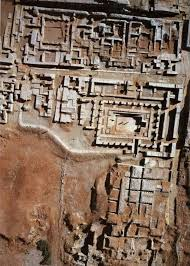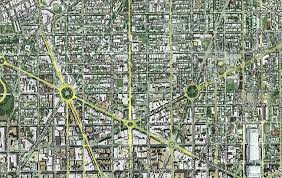Planning is the backbone of development activities. It points out a precise way to reach a pre-determined goal or a set of goals within a pre-determined period of time with the means that are available with a planner and under the prevailing circumstances. Planning as a process involves investment and other development possibilities based on a consideration of economic and social costs and benefits. The practice of town planning is much older than the modern profession. And its desired effects have grown. The aims of planning have varied – to create grandeur, to promote empire and to instill civic pride. In this article, we shall study the meaning and objectives of town planning.
Town planning is the process of managing land resources. It involves the control of existing and new developments, as well as strategy preparation to ensure manage future requirements. It is a dynamic process that changes in response to policy, development proposals and local needs. The need of town planning has been arisen due to the rising health issues because of overpopulation, poor sanitation, and pollution.
Defining Town Planning:
According to John T. Howard, “Town planning is the guidance of the growth and change of urban areas. As such, it is aimed at fulfilling social and economic objectives which go beyond in physical form, and arrangement of buildings, streets, parks, utilities and other patterns of urban development”.
According to Thomas Adam, “Town planning is the art of planning the physical development of urban communities with the general object of security, healthy and safe living and working conditions, providing efficient and convenient forms of circulation and advancing the general public welfare. It aims at the preservation of natural beauty as essential to healthy living conditions, and leads to the promotion of beauty in building as a by-product of sound social and economic growth”.
According to Lewis Mumford, “City planning involves the co-ordination of human activities in time and space, on the basis of known facts about place, work and people. It involves the modification and co-relation of various elements in the total environment for the purpose of increasing their service to the community, and it calls for the building of appropriate structure, dwellings, industrial plants, markets, water works, drains, bridges, villages, cities to house the activities of community to assist the performance of all its needful functions in a timely and orderly fashion”.
History of Town Planning:
Indian Scholar and ancient economist in his book on economics “Koutiliya Arthashastra” said that that the cities should be freed from the excess population and some population should be resettled in new built towns. People should be encouraged to settle in these new towns.

The Indo-Gangetic region formed the cradle of Indus valley civilization about 5000 years ago. Harappan city sites, including Mohenjo Daro, Harappa, Kalibangan, and Surkotada are the examples of town planning. The orientation of streets and buildings are according to the cardinal directions east-west, and north-south. The building materials used were mud-bricks and kiln-fired-bricks, wood and reeds. The excavation revealed existence of private houses, large houses surrounded by smaller units, large public structures, and public utility structures like great baths, drains, etc.
China has a tradition of urban planning dating back thousands of years. The Mesopotamians, Minoans (Romans) and Egyptians used concept of town planning in the 8th century BC.
Problems faced due to not planning for towns:
- Lack of essential amenities like electricity, water supply and drainage.
- Uncontrolled development of the town.
- Unhealthy conditions
- Development of slums.
- Defective road system resulting in the formation of narrow streets and lanes.
- Heavy traffic congestions during the peak of hours of working period.
- Haphazard location of some industrial units of small and medium scale.
- Inadequate open spaces for parks and playgrounds.
- Noisy atmosphere in some localities.
- Waste disposal problems.
- Housing problems.
- Lack of public awareness for Community benefits and exploiting means of amenities and utility service facilities provided by the concerned authorities.
- Lack of engineering infrastructure.
- Inadequate ware houses and industrial sites.
- Defective locations of schools.
- Inadequate space on the main roads for footpath and town squares, circles, etc.
Objectives of Town Planning:

To help city to grow:
Many countries are confronted with an alarming growth of population, excessive urbanization and metropolitization. The growth pattern of urban settlements is in imbalance. Bulk of the urban population is concentrated in a few large cities, most of them capitals of the countries and a few business hubs. Town planning helps in making early plans to accommodate the increase in the population. During town planning certain factors like the needs of citizens (residential, leisure, and healthcare), and needed infrastructure (roads, good transportation, law enforcing agencies) should be considered.
To improve quality of life:
Only increase in GDP or standard of living doesn’t mean human development. For complete development of people, there should be improvement in their quality of life. A care is taken by town planners for the proper distribution of land, public spaces, traffic regulations, collection and disposal of garbage, and the infrastructures. It also helps in creating better and efficient health care system.
To Predict Disaster:
Town planning helps the citizens as well as the visitors safe from all possible disasters by predicting possible natural calamities like water logging, tsunamis, storms, and cyclones. Thus risk is minimized.
To improve Economy of the Nation:
Town planning provides better facilities by lowering the cost of living. It improves the economic activity in the country. It improves job potential. It allows the local bodies to accept the migrated population effectively. The rural areas are utilized to bring economic growth to the city. This improves the economy of the nation.
Scope of Town Planning:
- the orderly arrangement of the city’s residential, commercial and administrative divisions in such a manner that each part could function without much overlapping;
- an efficient system of roads connecting different parts of the town, and the town with the outside world;
- the provision of safe, sanitary and comfortable housing in a variety of dwelling types to meet the needs of all types of families;
- the provision of recreation, schools and other community services of a high standard; and
- the provision of adequate water supply, public utilities, and services.